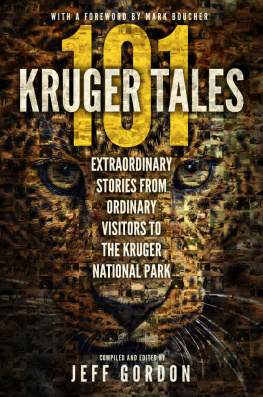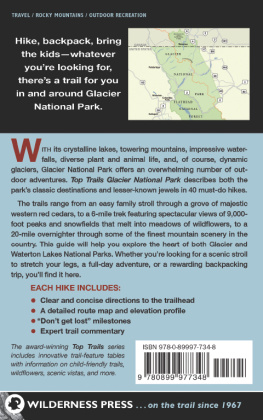

This book is dedicated to The Great Conservator.
Published by Struik Nature
(an imprint of Random House Struik (Pty) Ltd)
Reg. No. 1966/003153/07
First Floor, Wembley Square, Solan Road, Gardens, Cape Town, 8001
PO Box 1144, Cape Town, 8000 South Africa
Visit www.randomstruik.co.za and join the Struik Nature Club for updates, news, events and special offers
First published by SA Country Life 1978
First published by Struik Publishers 1992
Revised edition published in 2014 by Struik Nature
10 9 8 7 6 5 4 3 2 1
Copyright in text, 2014: Estate of P. F. Fourie
Copyright in illustrations, 2014: David Thorpe, except where indicated in picture credits below
Copyright in published edition, 2014: Random House Struik (Pty) Ltd
Copyright in maps, 2014: Random House Struik (Pty) Ltd
(Kruger ecozone map reproduced with the kind permission of Dr Freek Venter, Kruger National Park)
Picture credits: Front cover: Mario Moreno/South Cape Images;
Back cover: Nigel Dennis/Images of Africa; Peter Hayman/Random House Struik (Pty) Ltd: pp .
Editor: Lesley Hay-Whitton
Project manager: Colette Alves
Typesetter: Tessa Fortuin
Cover designer: Janice Evans
Cartographer: Martin Endemann
Proofreader and indexer: Thea Grobbelaar
Reproduction by Hirt & Carter Cape (Pty) Ltd
Printing and binding: Toppan Leefung Packaging and Printing (Dongguan) Co., Ltd, China
All rights reserved. No part of this publication may be reproduced, stored in a retrieval system, or transmitted, in any form or by any means, electronic, mechanical, photocopying, recording or otherwise, without the prior written permission of the copyright owner(s).
ISBN 978 1 77584 014 5 (Print)
ISBN 978 1 77584 154 8 (ePUB)
ISBN 978 1 77584 155 5 (ePDF)
CONTENTS
ACKNOWLEDGEMENTS
The writing of any book to be used as reference, even in a recreational sense, is a team effort and I wish to express my appreciation to the following persons who assisted in the final product.
Firstly I wish to extend my gratitude to the original authors son, Dr Dave Fourie, for entrusting me with the updating, editing and extension of his late fathers book.
This publication is based entirely on factual correctness. My sincere appreciation goes to my former colleagues and other experts in their field, for reading the scripts to ensure the factual correctness of this publication. Without their input this publication would not have been possible.
I gratefully acknowledge the assistance of Dr L. E. O. Braack, Dr Andrew Deacon, Dr Sam Ferreira, Dr Salomon Joubert, Dr Johan Marais, Dr Gus Mills, Dr Danie Pienaar, Dr Freek Venter, Dr Ian Whyte, Mr Nic de Beer, Ms Navashni Govender, Mr Ken Maggs, Mr Joep Stevens and Mrs Guin Zambatis, as well as the staff of various departments, but especially staff of the Scientific Services at Skukuza.
For his time proofreading the manuscript of the book and for his advice and guidance, my sincere appreciation to Dr Salomon Joubert.
Lastly, I wish to record my appreciation to Mr David Mabunda, CEO of SANParks, for his encouragement in tackling this project.
CHRIS VAN DER LINDE
Pretoria 2013

PREFACE TO THE 7TH EDITION
Although this seventh edition of the late P. F. Fouries Kruger National Park Questions and Answers introduces a new author/editor, it does not introduce any change in policy or intent.
When I approached the late Fritz Fouries son, Dr Dave Fourie, with the view of updating the sixth edition and adding the new happenings in the Kruger National Park, I was pleased with his positive response.
One of the main reasons for my revision of the book was the incredible ignorance I encountered, especially among some tour guides accompanying visitors to the Kruger Park and their unbelievable lack of knowledge of the Park, its fauna and flora. I hope that, with this revised publication, the correct information will assist tour guides in making their guests visits memorable.
The publication is, of course, also directed at the regular visitors to this wonderful conservation area, in the hope that it will bring an understanding of how nature functions and that they will be enriched by the knowledge imparted by the experts in their field who assisted in checking the publications factual correctness.
It is also hoped that this publication will become an integral part of libraries, especially those of educational institutions, to assist students with the correct information for assignments regarding the Park and its ecological component.
Some changes have been made to the contents of the previous editions, correcting points where new information became available. New subjects have been added to inform of new management decisions and the dramatic changes that occurred since the sixth edition appeared in 1992.
Tariffs and other economic parameters are prone to regular changes. For this reason no tariffs or any monetary implications are quoted in the publication. For up-to-date tariffs it is advisable to contact SANParks Head Office in Pretoria.
The scope of this book is wide and, with its additional chapters and information, it is hoped that it will enhance any visit to the Park.
Fritz Fourie was Chief Information Officer in the Park from 1969 to 1977. During this time he met many people from all walks of life and from all over the world, who regularly asked him questions about the Park. This formed the basis of the contents of this publication. A book such as this was his dream and throughout the various editions his love and respect for nature are reflected.
The sixth edition was updated by his good friend, Dr Gerrie de Graaf.
My own passion for the Kruger National Park encouraged me to revise and update the facts and to consolidate all the information in this publication. For me it was a privilege, an honour and a joy to be involved in something started by Fritz Fourie, continued by Dr De Graaf and supported by his family. My gratitude also goes to my friends, family and colleagues who assisted with the contents of this book.
It grieves me that Fritz cannot be with us to experience the seventh edition of what he initiated, but his spirit lives on in the pages of this book.
CHRIS VAN DER LINDE
Pretoria 2013
FOREWORD
Knowledge creates awareness, appreciation and respect. These, in turn, form the cornerstones of an environmental ethic. Creating and establishing an environmental ethic is exactly what national parks are all about. In fact, in conformation with the International Union for Conservation of Nature (IUCN), our own Protected Areas Act prescribes that a national park is created to provide spiritual, scientific, educational, recreational and tourism opportunities which are environmentally compatible.
The Kruger National Park is not only the flagship of our South African national parks, but also enjoys iconic status on an international scale. More than a million visitors, local and from abroad, pass through the park annually and are intrigued by its amazing diversity of landscapes, and plant and animal life. It is home to the full suite of Africas large carnivores, 18 species of antelope in addition to African elephant, black and white rhinoceros, giraffe and hippopotamus. It also accommodates 119 species of reptiles, 35 amphibians, more than 500 birds and a myriad insects.
Next page










